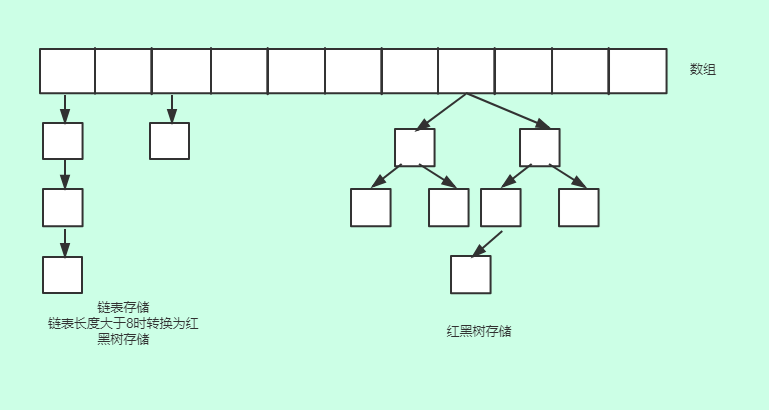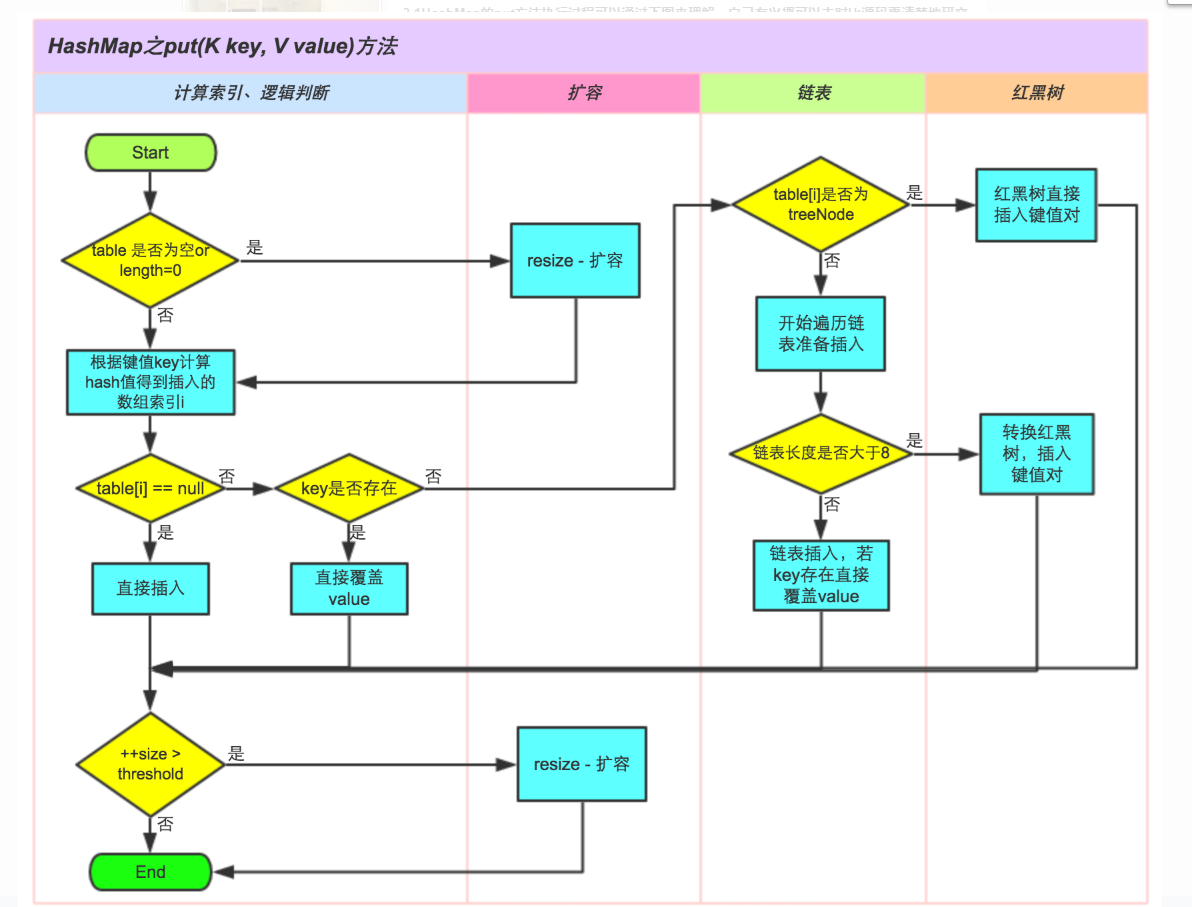JDK源码分析 – HashMap
HashMap类的申明
HashMap的定义如下:
1 public class HashMap<K,V> extends AbstractMap<K,V> 2 implements Map<K,V>, Cloneable, Serializable {}
HashMap是一个散列表,用于存储key-value形式的键值对。
从源码的定义中可以看到HashMap继承了AbstractMap抽象类而且也实现了Map<K,V>接口,AbstractMap类本身也继承了Map<K,V>接口,Map接口定义了一些map数据结构的基本操作, AbstractMap提供了Map接口的一些默认实现。
HashMap实现了Cloneable接口和Serializable接口,这两个接口本身并没有定义方法,属于申明式接口,允许hashmap进行克隆和序列化。
另外,HashMap不是线程安全的,如果需要使用线程安全的HashMap,可以使用Collections类中的synchronizedMap方法来获得线程安全的HashMap:
Map map = Collections.synchronizedMap(new HashMap());
HashMap主要字段属性说明
1 //hashmap的初始容量:16 2 static final int DEFAULT_INITIAL_CAPACITY = 1 << 4; // aka 16 3 4 //hashmap的最大容量,hashmap的容量必须是2的指数值 5 static final int MAXIMUM_CAPACITY = 1 << 30; 6 7 //默认填充因子 8 static final float DEFAULT_LOAD_FACTOR = 0.75f; 9 10 //链表转换为树的阀值:如果一个桶中的元素个数超过 TREEIFY_THRESHOLD=8 ,就使用红黑树来替换链表,从而提高速度 11 static final int TREEIFY_THRESHOLD = 8; 12 13 //树还原为链表的阈值:扩容时桶中元素小于UNTREEIFY_THRESHOLD = 6,则把树形的桶元素还原为链表结构 14 static final int UNTREEIFY_THRESHOLD = 6; 15 16 //哈希表的最小树形化容量:当哈希表中的容量大于这个值MIN_TREEIFY_CAPACITY = 64时,哈希表中的桶才能进行树形化,否则桶中元素过多时只会扩容,并不会进行树形化, 为了避免扩容和树形化选择的冲突,这个值不能小于4* TREEIFY_THRESHOLD = 32 17 static final int MIN_TREEIFY_CAPACITY = 64; 18 19 //hashmap用于存储数据的Node数组,长度是2的指数值 20 transient Node<K,V>[] table; 21 22 //保存entrySet返回的结果 23 transient Set<Map.Entry<K,V>> entrySet; 24 25 //hashmap中键值对个数 26 transient int size; 27 28 //hashmap对象修改计数器 29 transient int modCount; 30 31 // threshold=容量*装载因子,代表目前占用数组长度的最大值,用于判断是否需要扩容 32 int threshold; 33 34 //装载因子,用来衡量hashmap装载数据程度,默认值为EFAULT_LOAD_FACTOR = 0.75f,装载因子计算方法size/capacity 35 final float loadFactor;
很多资料上都会提到JDK1.8之前hashmap的通过数组+链表的数据结构实现的,这样在hash值大量冲突时hashmap是通过一个长长的链表来存储的,JDK1.8开始,hashmap采用数组+链表+红黑树组合数据结构来实现,链表和红黑树将会按一定策略互相转换,JDK1.8开始,hashmap的存储结构大致如下:

回顾一下关于红黑树的定义:
1. 每个结点或是红色的,或是黑色的
2. 根节点是黑色的
3. 每个叶结点(NIL)是黑色的
4. 如果一个节点是红色的,则它的两个儿子都是黑色的
5. 对于每个结点,从该结点到其子孙结点的所有路径上包含相同数目的黑色结点
HashMap部分方法析
构造函数
- 无参数构造函数:设置装载因子初始值0.75
1 public HashMap() { 2 this.loadFactor = DEFAULT_LOAD_FACTOR; // all other fields defaulted 3 }
- HashMap(int initialCapacity) :指定初始容量
public HashMap(int initialCapacity) { this(initialCapacity, DEFAULT_LOAD_FACTOR); }
- HashMap(int initialCapacity) :指定初始容量和装载因子
1 public HashMap(int initialCapacity, float loadFactor) { 2 //初始容量校验 3 if (initialCapacity < 0) 4 throw new IllegalArgumentException("Illegal initial capacity: " + 5 initialCapacity); 6 //校验初始容量不能超过hashmap最大容量:2的30次方 7 if (initialCapacity > MAXIMUM_CAPACITY) 8 initialCapacity = MAXIMUM_CAPACITY; //初始化为最大容量 9 //校验装载因子 10 if (loadFactor <= 0 || Float.isNaN(loadFactor)) 11 throw new IllegalArgumentException("Illegal load factor: " + 12 loadFactor); 13 this.loadFactor = loadFactor; 14 this.threshold = tableSizeFor(initialCapacity); 15 } 16 //根据根据初始化参数initialCapacity 返回大于等于该值得最小 2的指数值 作为初始容量 17 static final int tableSizeFor(int cap) { 18 int n = cap - 1; 19 n |= n >>> 1; 20 n |= n >>> 2; 21 n |= n >>> 4; 22 n |= n >>> 8; 23 n |= n >>> 16; 24 return (n < 0) ? 1 : (n >= MAXIMUM_CAPACITY) ? MAXIMUM_CAPACITY : n + 1; 25 }
这个构造函数可以发现初始化hashmap的容量并不是随意指定多少就初始化多少,内部根据传入的容量值做了转换,严格的将hashmap的初始容量转换成的2的指数值,比如我们初始化一个new HashMap(25),实际初始化处来的容量是32,相当于new HashMap(32)
- HashMap(Map<? extends K, ? extends V> m):初始化一个hashmap,使用默认加载因子0.75,并将hashmap参数值复制到新创建的hashmap对象中。
1 public HashMap(Map<? extends K, ? extends V> m) { 2 this.loadFactor = DEFAULT_LOAD_FACTOR; 3 putMapEntries(m, false); 4 }
put(K key, V value)
向hashmap中添加健值对
1 public V put(K key, V value) { 2 return putVal(hash(key), key, value, false, true); 3 } 4 5 //hash:hashkey 6 //key value :键值对 7 //onlyIfAbsent:为true则不修改已存在的value 8 //evict:返回被修改的value 9 final V putVal(int hash, K key, V value, boolean onlyIfAbsent, 10 boolean evict) { 11 12 Node<K,V>[] tab; 13 Node<K,V> p; 14 int n, i; 15 //如果table为null或者空,则进行resize扩容 16 if ((tab = table) == null || (n = tab.length) == 0) 17 //执行resize扩容,内部将初始化table和threshold 18 n = (tab = resize()).length; 19 //如果对应索引处没有Node,则新建Node并放到table里面 20 if ((p = tab[i = (n - 1) & hash]) == null) 21 tab[i] = newNode(hash, key, value, null); //tab[i]==null的情况,直接新创建节点并赋值给tab[i] 22 else { 23 //else的情况表示tab[i]不为null 24 Node<K,V> e; 25 K k; 26 //1:hash值与tab[i]的hash值相等且key也相等,那么覆盖该节点的value域 27 if (p.hash == hash && 28 ((k = p.key) == key || (key != null && key.equals(k)))) 29 e = p;//暂存tab[i]的节点p到临时变量e 30 //2:判断tab[i]是否是红黑树 31 else if (p instanceof TreeNode) 32 e = ((TreeNode<K,V>)p).putTreeVal(this, tab, hash, key, value);//添加到树形结构中 33 else { 34 //3:不是红黑树 且不是第1中情况,即:hash值一致,但是key不一致,那么需要将新的key-value添加到链表末尾 35 for (int binCount = 0; ; ++binCount) { 36 if ((e = p.next) == null) { 37 //添加到链表末尾 38 p.next = newNode(hash, key, value, null); 39 //如果该节点的链表长度大于8,则需要将链表转换为红黑树 40 if (binCount >= TREEIFY_THRESHOLD - 1) // -1 for 1st 41 treeifyBin(tab, hash); 42 break; 43 } 44 //如果key已经存在该链表中,直接break,执行后续更新逻辑 45 if (e.hash == hash && 46 ((k = e.key) == key || (key != null && key.equals(k)))) 47 break; 48 p = e; 49 } 50 } 51 if (e != null) { // existing mapping for key 52 V oldValue = e.value; 53 /hash值和key相等的情况下,更新value 54 if (!onlyIfAbsent || oldValue == null) 55 e.value = value; 56 // 57 afterNodeAccess(e); 58 //返回旧的value值 59 return oldValue; 60 } 61 } 62 //修改次数自增 63 ++modCount; 64 //判断是否需要再次扩容 65 if (++size > threshold) 66 resize(); 67 // 68 afterNodeInsertion(evict); 69 return null; 70 }
上面的代码即便加了注释,看上去也不是很清晰,csdn有篇文章分析了hashmap的这个方法,并给出了一个流程图,逻辑很清晰:

图片来源:https://blog.csdn.net/lianhuazy167/article/details/66967698
上面put方法的实现中用到了一个很重要的方法resize(),这个方法的作用是当hashmap集合中的元素已经超过最大承载容量时,则对hashmap进行容量扩充。最大装载容量threshold=capacity*loadFactor,这个值一般小于数组的长度,下面看一下这个方法的实现过程:
1 //初始化或者是扩展table的容量,table的容量时按照2的指数增长的,当扩大table容量时,元素的hash值以及位置可能发生改变 4 final Node<K,V>[] resize() { 5 Node<K,V>[] oldTab = table; 6 //计算当前哈希表 table数组长度 7 int oldCap = (oldTab == null) ? 0 : oldTab.length; 8 //当前阈值(装载容量=数组长度*装载因子) 9 int oldThr = threshold; 10 int newCap, newThr = 0; 11 //如果table数组长度大于0 12 if (oldCap > 0) { 13 //table数组长度大于等于hashmap默认的最大值: 2的30次方 14 if (oldCap >= MAXIMUM_CAPACITY) { 15 //扩充为为int型最大值 16 threshold = Integer.MAX_VALUE; 17 return oldTab; 18 } 19 //如果table数据长度>=初始化长度(16) 而且 扩展1倍也小于默认最大长度:2的30次方 20 else if ((newCap = oldCap << 1) < MAXIMUM_CAPACITY && 21 oldCap >= DEFAULT_INITIAL_CAPACITY) 22 // threshold 阈值扩大一倍 23 newThr = oldThr << 1; // double threshold 24 } 25 //如果原先的装载容量>0,直接将新容量赋值为 原先的装载容量oldThr->oldThreshold 26 else if (oldThr > 0) // initial capacity was placed in threshold 27 newCap = oldThr; 28 else { // zero initial threshold signifies using defaults 29 //原先的阈值oldThr< =0 而且table长度也=0,这说明hashmap还未初始化,执行初始化 30 newCap = DEFAULT_INITIAL_CAPACITY;//数组长度赋值16 31 newThr = (int)(DEFAULT_LOAD_FACTOR * DEFAULT_INITIAL_CAPACITY); // 32 } 33 //计算新的阈值上限 34 if (newThr == 0) { 35 float ft = (float)newCap * loadFactor; 36 newThr = (newCap < MAXIMUM_CAPACITY && ft < (float)MAXIMUM_CAPACITY ? 37 (int)ft : Integer.MAX_VALUE); 38 } 39 //更新为新的阈值 40 threshold = newThr; 41 //重新分配table容量 42 @SuppressWarnings({"rawtypes","unchecked"}) 43 Node<K,V>[] newTab = (Node<K,V>[])new Node[newCap]; 44 table = newTab; 45 //把原先table中的复制到新的table中 46 if (oldTab != null) { 47 for (int j = 0; j < oldCap; ++j) { 48 Node<K,V> e; 49 if ((e = oldTab[j]) != null) { 50 oldTab[j] = null; 51 if (e.next == null) 52 newTab[e.hash & (newCap - 1)] = e; 53 else if (e instanceof TreeNode) 54 ((TreeNode<K,V>)e).split(this, newTab, j, oldCap); 55 else { // preserve order 56 Node<K,V> loHead = null, loTail = null; 57 Node<K,V> hiHead = null, hiTail = null; 58 Node<K,V> next; 59 do { 60 next = e.next; 61 if ((e.hash & oldCap) == 0) { 62 if (loTail == null) 63 loHead = e; 64 else 65 loTail.next = e; 66 loTail = e; 67 } 68 else { 69 if (hiTail == null) 70 hiHead = e; 71 else 72 hiTail.next = e; 73 hiTail = e; 74 } 75 } while ((e = next) != null); 76 if (loTail != null) { 77 loTail.next = null; 78 newTab[j] = loHead; 79 } 80 if (hiTail != null) { 81 hiTail.next = null; 82 newTab[j + oldCap] = hiHead; 83 } 84 } 85 } 86 } 87 } 88 return newTab; 89 }
Hashmap的扩容机制主要实现步骤:
-
如果当前数组为空,则初始化当前数组(长度16,装载因子0.75)
-
如果当前数组不为空,则将当前数组容量扩大一倍,同时将阈值(threshold)也扩大一倍,然后将之前table素组中值全部复制到新的table中
get(Object key)
通过key获取对应的value,实现逻辑:根据key计算hash值,通过hash值和key从hashmap中检索出唯一的结果并返回。
1 public V get(Object key) { 2 Node<K,V> e; 3 return (e = getNode(hash(key), key)) == null ? null : e.value; 4 } 5 //hash:key对应的hash值 6 //key:键值对的key 7 final Node<K,V> getNode(int hash, Object key) { 8 Node<K,V>[] tab; Node<K,V> first, e; int n; K k; 9 10 if ((tab = table) != null && (n = tab.length) > 0 && 11 (first = tab[(n - 1) & hash]) != null) { // tab[(n - 1) & hash] 12 // 根据hash值计算出table中的位置,如果该位置第一个节点 key 和 hash值都和传递进来的参数相等,则返回该Node 13 if (first.hash == hash && // always check first node 14 ((k = first.key) == key || (key != null && key.equals(k)))) 15 return first; 16 //该键值对在hash表(n - 1) & hash索引处,但是不是第一个节点,多以遍历该链表(也可能是红黑树),不管是链表还是树,顺藤摸瓜就对了 17 if ((e = first.next) != null) { 18 //如果是红黑树,则遍历树型结构 19 if (first instanceof TreeNode) 20 return ((TreeNode<K,V>)first).getTreeNode(hash, key); 21 //不是树,遍历链表 22 do { 23 if (e.hash == hash && 24 ((k = e.key) == key || (key != null && key.equals(k)))) 25 return e; 26 } while ((e = e.next) != null); 27 } 28 } 29 return null; 30 } 31 32 //计算hash值 33 static final int hash(Object key) { 34 int h; 35 return (key == null) ? 0 : (h = key.hashCode()) ^ (h >>> 16); 36 }
get方法逻辑并没有什么难懂得地方,但是过程中有两个地方需要额外注意一下:
-
tab[(n - 1) & hash]): 根据hash值计算元素位置,其中n为hashmap中table数组长度,这里使用(n-1)&hash的方式计算索引位置,简单解释一下这个含义,hashmap中数组的大小总是2的指数值,这种特殊的情况之下(n-1)&hash等同于hash%n取模运算结果,并且使用(n-1)&hash位运算的方式效率上也高于取模运算。
-
hash(key):计算hash值,这个函数并不是直接通过hashCode()获取hash值,而是做了一步位运算(h = key.hashCode()) ^ (h >>> 16),即将hashcode的高16为与低16位异或运算,为什么这么做呢?因为hashcode()返回的是一个32位的int类型数值,将该数值的高16位与低16位做异或运算主要是想让高位数据参与运算,增加hash值得随机性。


